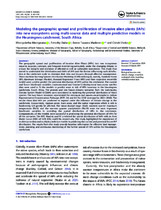| dc.contributor.author | Mtengwana, Bhongolethu | |
| dc.contributor.author | Dube, Timothy | |
| dc.contributor.author | Mudereri, Bester Tawona | |
| dc.date.accessioned | 2022-02-14T13:03:31Z | |
| dc.date.available | 2022-02-14T13:03:31Z | |
| dc.date.issued | 2021 | |
| dc.identifier.citation | Mtengwana, B. et al. (2021). Modeling the geographic spread and proliferation of invasive alien plants (IAPs) into new ecosystems using multi-source data and multiple predictive models in the Heuningnes catchment, South Africa. GIScience and Remote Sensing, 58(4), 483–500. https://doi.org/10.1080/15481603.2021.1903281 | en_US |
| dc.identifier.issn | 1943-7226 | |
| dc.identifier.uri | https://doi.org/10.1080/15481603.2021.1903281 | |
| dc.identifier.uri | http://hdl.handle.net/10566/7248 | |
| dc.description.abstract | The geographic spread and proliferation of Invasive Alien Plants (IAPs) into new ecosystems
requires accurate, constant, and frequent monitoring particularly under the changing climate to
ensure the integrity and resilience of affected as well as vulnerable ecosystems. This study thus
aimed to understand the distribution and shifts of IAPs and the factors influencing such distribution at the catchment scale to minimize their risks and impacts through effective management.
Three machine learning Species Distribution Modeling (SDM) techniques, namely, Random Forest
(RF), Maximum Entropy (MaxEnt), Boosted Regression Trees (BRT) and their respective ensemble
model were used to predict the potential distribution of IAPs within the catchment. The current
and future bioclimatic variables, environmental and Sentinel-2 Multispectral Instrument satellite
data were used to fit the models to predict areas at risk of IAPs invasions in the Heuningnes
catchment, South Africa. The present and two future climatic scenarios from the Community
Climate System Model (CCSM4) were considered in modeling the potential distribution of these
species. The two future scenarios represented the minimum and maximum atmospheric carbon
Representative Concentration Pathways (RCP) 2.6 and 8.5 for 2050 (average for 2041–2060). | en_US |
| dc.language.iso | en | en_US |
| dc.publisher | Taylor and Francis | en_US |
| dc.subject | Biological invasion risk | en_US |
| dc.subject | Climate change | en_US |
| dc.subject | South Africa | en_US |
| dc.subject | Invasive Alien plant | en_US |
| dc.subject | Ensemble | en_US |
| dc.title | Modeling the geographic spread and proliferation of invasive alien plants (IAPs) into new ecosystems using multi-source data and multiple predictive models in the Heuningnes catchment, South Africa | en_US |
| dc.type | Article | en_US |

